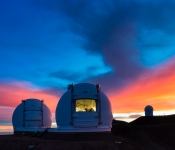More Than 100 New Exoplanets Confirmed
From the summit of Hawai‘i’s dormant Mauna Kea volcano, astronomers at the W.M. Keck Observatory continue to probe the local and distant universe with unprecedented power and precision.
An international team of astronomers, including scientists from Keck, have confirmed the discovery of more than 100 exoplanets—the biggest haul of worlds uncovered by the stabilized and repurposed Kepler space telescope in its K2 mission.
The new population includes many worlds that could be rocky and cool enough to potentially support life—including the first planetary system comprising four planets potentially similar to Earth.
The researchers achieved this discovery by combining NASA’s K2 mission data with follow-up observations by the Keck Observatory and the twin Gemini telescopes on Maunakea, as well as other observatories in Chile, California and Arizona.

Image montage showing the Maunakea Observatories, Kepler Space Telescope, and night sky with K2 Fields and discovered planetary systems (dots) overlaid. An international team of scientists discovered more than 100 planets based on images from Kepler operating in the ‘K2 Mission’. The team confirmed and characterized the planets using a suite of telescopes worldwide, including four on Maunakea (the twin telescopes of Keck Observatory, the Gemini-North Telescope, and the Infrared Telescope Facility). The planet image on the right is an artist’s impression of a representative planet. CREDIT: KAREN TERAMURA/IFA, MILOSLAV DRUCKMÜLLER, NASA
Ironically, the discovery was made possible when the Kepler space telescope’s pointing system broke.
In its initial mission, Kepler surveyed a specific patch of sky in the northern hemisphere, measuring the frequency with which planets with sizes and temperatures similar to Earth’s occur around stars like our sun.
But when it lost its ability to precisely “stare” at its original target area in 2013, engineers created a second life for the telescope that is proving remarkably fruitful.
Its new mission, dubbed K2, has provided the capability of observing a series of independent target fields in the ecliptic plane with greater opportunities for Earth-based observatories in both the northern and southern hemispheres.
Additionally, in contrast to the Kepler mission, K2 is an entirely community-driven mission with all targets proposed by the scientific community.
K2 now looks at a larger fraction of cooler, smaller, red dwarf-type stars, which are much more common in the Milky Way than sun-like stars.
“Kepler’s original mission observed a small patch of sky as it was designed to conduct a demographic survey of the different types of planets,” said Ian Crossfield, a Sagan Fellow at the University of Arizona’s Lunar and Planetary Laboratory, who led the research effort. “This approach effectively meant that relatively few of the brightest, closest red dwarfs were included in Kepler’s survey. The K2 mission allows us to increase the number of small, red stars by a factor of 20 for further study.”
One of the most interesting sets of planets discovered in this study is a system of four potentially rocky planets, between 20% and 50% larger than Earth, orbiting a star less than half the size and with less light output than the sun.
Their orbital periods range from 5.5 to 24 days; two of them may experience radiation levels from their star comparable to those on Earth.
Despite their tight orbits, which are closer than Mercury’s orbit around the sun, the possibility that life could arise on a planet around such a star cannot be ruled out, according to Crossfield.
“Because these smaller stars are so common in the Milky Way, it could be that life occurs much more frequently on planets orbiting cool, red stars rather than planets around stars like our sun,” Crossfield said.
The W.M. Keck Observatory operates the largest, most scientifically productive telescopes on Earth. The two 10-meter optical/infrared telescopes near the summit of Maunakea feature a suite of advanced instruments including imagers, multi-object spectrographs, high-resolution spectrographs, integral-field spectrographs and world-leading laser guide star adaptive optics systems.
Keck’s HIRES (the High-Resolution Echelle Spectrometer) is famous for finding planets orbiting other stars. Astronomers also use HIRES to study distant galaxies and quasars, finding clues to the Big Bang.
Keck Observatory is a private 501(c)3 non-profit organization and a scientific partnership of the California Institute of Technology, the University of California and NASA.
Find more information online.









